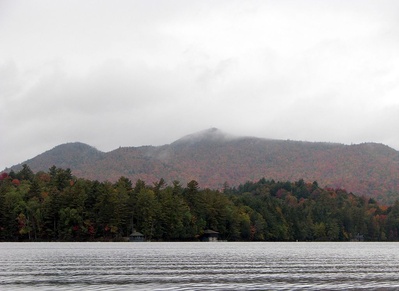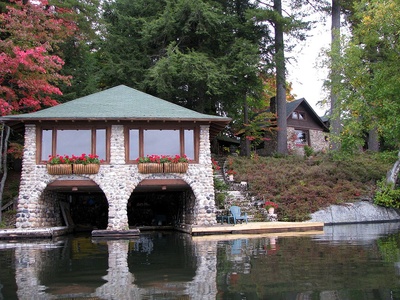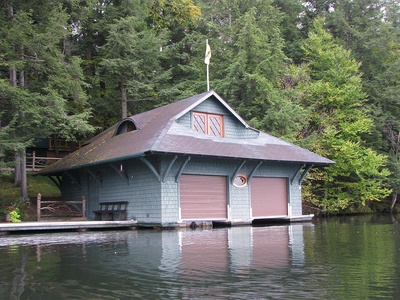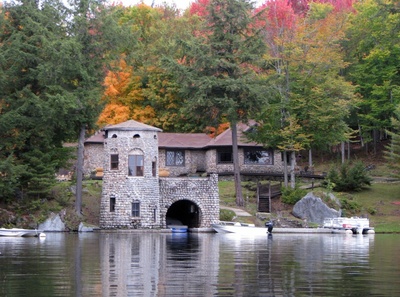 St. Regis Mountain from Spitfire Lake
St. Regis Mountain from Spitfire Lake  A "Camp" on Spitfire Lake Two hundred and fifty-acre Spitfire Lake is a part of the St. Regis River in the Adirondacks. Along with Upper and Lower St. Regis Lake, it became famous in the late 19th century as a summer playground of America's power elite, drawn to the area by its scenic beauty and by the rustic charms of Paul Smith's Hotel. It is the site of many grand old summer "cottages" and Great Camps; Frederick W. Vanderbilt, Anson Phelps Stokes and Whitelaw Reid were among the summer residents. "The camps of many of these families began as tent colonies, with separate units for sleeping, dining, games, and so on, and evolved into permanent structures built with understated taste." 1
A "Camp" on Spitfire Lake Two hundred and fifty-acre Spitfire Lake is a part of the St. Regis River in the Adirondacks. Along with Upper and Lower St. Regis Lake, it became famous in the late 19th century as a summer playground of America's power elite, drawn to the area by its scenic beauty and by the rustic charms of Paul Smith's Hotel. It is the site of many grand old summer "cottages" and Great Camps; Frederick W. Vanderbilt, Anson Phelps Stokes and Whitelaw Reid were among the summer residents. "The camps of many of these families began as tent colonies, with separate units for sleeping, dining, games, and so on, and evolved into permanent structures built with understated taste." 1
Spitfire is part of the original Seven Carries canoe route from Paul Smith's Hotel to Saranac Inn.
Forest and Stream, Volume 36, Forest and Stream Publishing Company, New York, June 1891, p. 435 (full text here)
THE ST. REGIS CAMPS.
NOWHERE in the entire Adirondack region are the camps as numerous or as elaborate in their appointments as on the lakes immediately in the neighborhood of Paul Smith's Hotel, over 100 being situated within a radius of three miles from the hotel. This house is on the northern shore of the lower, but most northerly, of the two St. Regis lakes. Between these two, connected with them by narrow streams or runways for the water— "slews" the natives call them—is Spitfire Lake. North of Smith's about one-half mile is Osgood Pond. The banks of these lakes are owned by private individuals, who have erected upon them permanent camps, some of which have cost many thousands of dollars. Land on their shores is variously held at from $2,500 to $10,000 an acre.
 Boat house on Spitfire Lake
Boat house on Spitfire Lake  Camp Cobblestone […]
Camp Cobblestone […]
The finest camp on Spitfire is owned by Mr. S. T. Drake, the Game Commissioner. This is situated on the northwest shore of the lake, and consists of a series of buildings connected by verandahs; the interior of which are decorated with woodland and hunting scenes and the heads and skins of game.
Adirondack Daily Enterprise, November 17, 1969
YOUNG HUNTER LOST, FOUND
A Plattsburgh University student, Glenn Peoples, hunting in the Tongue Peninsula-Spitfire Lake area Sunday afternoon, be came separated from his party and was found by the Saranac Lake Forest Ranger, Frank Dorchak, and volunteers at 9:15 that evening.
When Peoples did not show up at nightfall, Art Fleury, his hunting partner, and Bill Hall of Paul Smiths began searching the log roads and area where he was last seen.
At 7:30 Bob Jaquis, of Paul Smiths, notified the ranger who after meeting with the search party consisting of Jaquis his son, Charles Martin, and Bill Hall left in a boat from the Trevor camp on Spitfire Lake in company with Bob Rottner, caretakcr of the Trevor camp, and found the lost hunter at a campsite at a private lean-to east of the Sawyer camp on Spitfire Lake. On the way back to the Trevor camp, Fleury who had been searching along the shore, was picked up.
Camps:
See also St. Regis Lakes
Sources
• Donaldson, Alfred L., A History of the Adirondacks. New York: Century, 1921. ISBN 0-916346-26-8. (reprint)
• Jerome, Christine Adirondack Passage: Cruise of Canoe Sairy Gamp, HarperCollins, 1994. ISBN 0-93527294-1.
External links
• ''New York Times'', "Point Racing at Paul Smiths", August 9, 1909. (pdf)
• ''New York Times'', "Yacht Racing on St. Regis Lake", August 7, 1904. (pdf)
Comments
Footnotes
1. Jerome, p. 109



